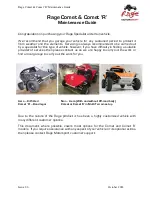
Camber Gain:
Camber Gain:
Camber Gain:
Camber Gain:
Camber Gain: Angle of the Camber Link relative to the Suspension Arm. Lowering the
camber link on the shock tower OR raising the camber link on the castor block will INCREASE
the camber angle of the tire when the suspension is compressed. Raising the camber link on
the shock tower OR lowering the camber link on the castor block will DECREASE the camber
angle of the tire when the suspension is compressed. There is not a “correct” set-up and once
again too much of anything is generally bad. This will help change the “feel” of the car thru
the turns.
Camber Link Length:
Camber Link Length:
Camber Link Length:
Camber Link Length:
Camber Link Length: Comparing this to the length of the Suspension Arm from each pivot
point and keeping the Camber the same, making the link
shorter will decrease traction for
that corner of the car while making it
longer will increase traction for that corner of the car.
Once the camber link is equal to or greater than the Suspension Arm pivots, the gain of
traction ends. Also a shorter camber link will increase camber gain and a longer decrease
camber gain.
Shock Angle:
Shock Angle:
Shock Angle:
Shock Angle:
Shock Angle: Leaning the shock toward the car is effectively like changing to a
softer spring.
Standing the shock closer to vertical is effectively like changing to a
stiffer spring. Try when
the car is working well and when one spring change is TOO much for your set-up.
Ride Height:
Ride Height:
Ride Height:
Ride Height:
Ride Height: Check by pushing the chassis down once or twice to simulate bumps on the
track. Having the front end
higher than the rear will make the car increase rear traction
especially out of the turn. Having the front end
lower than the front will make the car
increase front traction especially entering the turn. Generally its safe to start the car with the
ride heights even.
Rear Toe-In:
Rear Toe-In:
Rear Toe-In:
Rear Toe-In:
Rear Toe-In: Front edge of car tires point
toward the chassis as viewed from above the car.
Increasing the angle toward the car will increase rear traction while decreasing front traction.
Decreasing the angle will do the opposite.
SET-UP GLOSSARY:
SET-UP GLOSSARY:
SET-UP GLOSSARY:
SET-UP GLOSSARY:
SET-UP GLOSSARY:
Caster:
Caster:
Caster:
Caster:
Caster: Angle of the kingpin in relation to a vertical plane as viewed from the side of the car.
Increasing the angle will make the car more stable out of the turn and down the straights and
increase steering entering a turn. Decreasing the angle will make the car feel more “touchy” at high
speeds and help steering while exiting the turn.
SET-UP GUIDELINES:
SET-UP GUIDELINES:
SET-UP GUIDELINES:
SET-UP GUIDELINES:
SET-UP GUIDELINES:
When looking for the “perfect set-up” it is important to remember 2 things...
1) Keeping things simple is best.
2) As you are making your set-up change, the track is changing too! Ask a local racer what the
track usually does from begining to end, especially day to night.
- Start your car’s ride height with it equal at all four corners to start. Use the shock collars to adjust
ride height by measuring the distance under the chassis when the car is sitting on a FLAT & LEVEL
surface.
- Shock collars can only jack weight and adjust the car’s handling when the car makes ALL 4
shocks squat when the car is set down. Use the RF shock collar to adjust how the car ENTERS the
corner. Use the RR shock collar to adjust how the car exits the corner ON-POWER. Use the LF shock
collar to make the car turn in less, and off the corner more.
- It is best to have a little bit of brake drag when you let off the gas, this will allow for a more
controlable car in ALL conditions. Increasing how much the brake drags will make your car turn
into the corner harder but can make the car also much more loose to drive into the corner.































